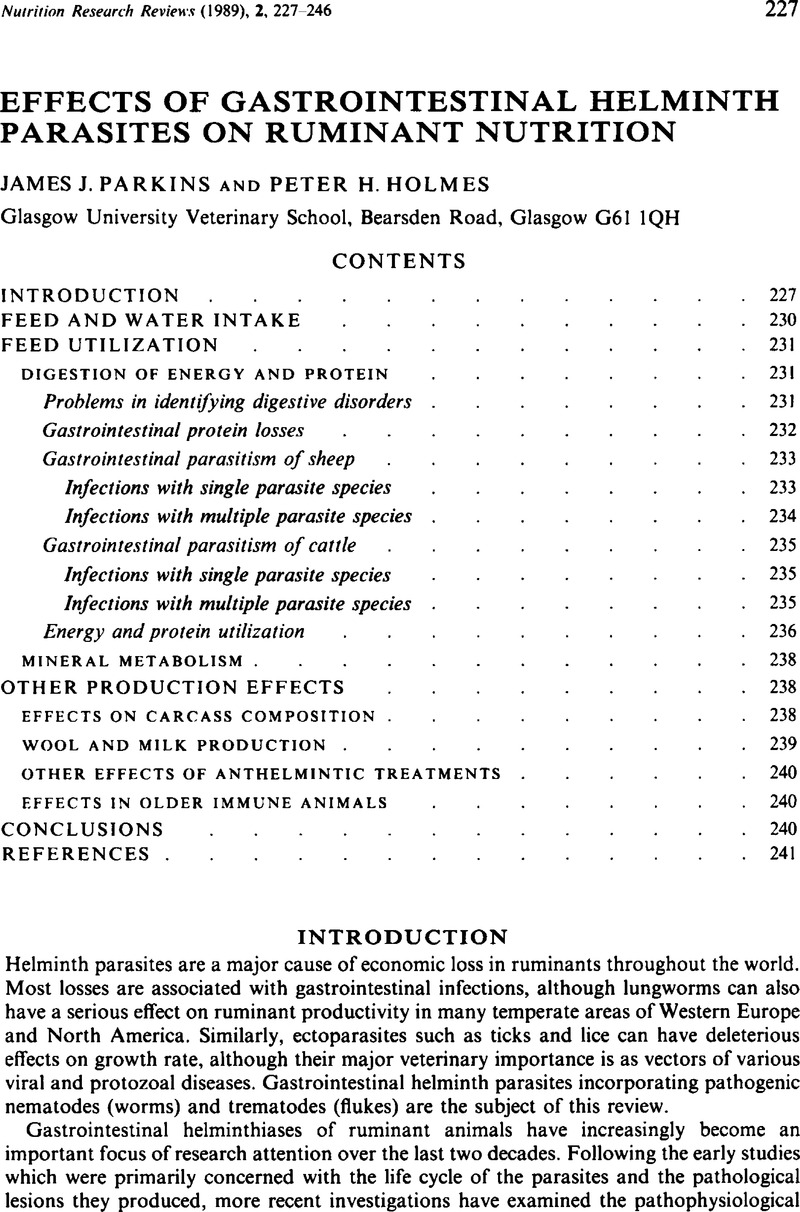Crossref Citations
This article has been cited by the following publications. This list is generated based on data provided by Crossref.
Pathak, A. K.
Dutta, Narayan
Banerjee, P. S.
Pattanaik, A. K.
and
Sharma, K.
1970.
Influence of Dietary Supplementation of Condensed Tannins through Leaf Meal Mixture on Intake, Nutrient Utilization and Performance of Haemonchus contortus Infected Sheep.
Asian-Australasian Journal of Animal Sciences,
Vol. 26,
Issue. 10,
p.
1446.
MacRae, John C.
1993.
Metabolic consequences of intestinal parasitism.
Proceedings of the Nutrition Society,
Vol. 52,
Issue. 1,
p.
121.
McKellar, Q.A.
1993.
Interactions of Ostertagia species with their bovine and ovine hosts.
International Journal for Parasitology,
Vol. 23,
Issue. 4,
p.
451.
Fox, M.T.
1993.
Pathophysiology of infection with Ostertagia ostertagi in cattle.
Veterinary Parasitology,
Vol. 46,
Issue. 1-4,
p.
143.
Holmes, Peter H.
1993.
Interactions between parasites and animal nutrition: the veterinary consequences.
Proceedings of the Nutrition Society,
Vol. 52,
Issue. 1,
p.
113.
Armour, J.
1994.
W.A.A.V.P. and Pfizer award for excellence in research in veterinary parasitology. Veterinary helminthology 1954–1993: a personal view of four decades of research.
Veterinary Parasitology,
Vol. 54,
Issue. 1-3,
p.
11.
Coop, R.L.
and
Holmes, P.H.
1996.
Nutrition and parasite interaction.
International Journal for Parasitology,
Vol. 26,
Issue. 8-9,
p.
951.
Van Houtert, Martin F.J.
and
Sykes, Andrew R.
1996.
Implications of nutrition for the ability of ruminants to withstand gastrointestinal nematode infections.
International Journal for Parasitology,
Vol. 26,
Issue. 11,
p.
1151.
Knox, Malcolm
and
Steel, John
1996.
Nutritional enhancement of parasite control in small ruminant production systems in developing countries of south-east Asia and the Pacific.
International Journal for Parasitology,
Vol. 26,
Issue. 8-9,
p.
963.
Fox, M.T.
1997.
Pathophysiology of infection with gastrointestinal nematodes in domestic ruminants: recent developments.
Veterinary Parasitology,
Vol. 72,
Issue. 3-4,
p.
285.
Thamsborg, S.M.
Jørgensen, R.J.
Ranvig, H.
Bartlett, P.
Waller, P.J.
and
Nansen, P.
1998.
The performance of grazing sheep in relation to stocking rate and exposure to nematode infections.
Livestock Production Science,
Vol. 53,
Issue. 3,
p.
265.
Petkevičius, Saulius
1998.
The Influence of Host Diet and Fasting on Helminth Infection: review.
Acta Zoologica Lituanica,
Vol. 8,
Issue. 1,
p.
29.
Tamminga, S.
and
Schrama, J. W.
1998.
Environmental effects on nutrient and energy metabolism in ruminants.
Archiv für Tierernaehrung,
Vol. 51,
Issue. 2-3,
p.
225.
Coop, R.L.
and
Kyriazakis, I.
1999.
Nutrition–parasite interaction.
Veterinary Parasitology,
Vol. 84,
Issue. 3-4,
p.
187.
Suarez, V.H
Lorenzo, R.M
Busetti, M.R
and
Santucho, G.M
1999.
Physiological and parasitological responses to nematode infections of fattening cattle in the Western Pampas of Argentina.
Veterinary Parasitology,
Vol. 81,
Issue. 2,
p.
137.
Saumell, C.A.
Padilha, T.
and
Santos, C. de P.
2000.
Nematophagous fungi in sheep faeces in Minas Gerais, Brazil.
Mycological Research,
Vol. 104,
Issue. 8,
p.
1005.
SIMPSON, H.V
2000.
Pathophysiology of Abomasal Parasitism: Is the Host or Parasite Responsible?.
The Veterinary Journal,
Vol. 160,
Issue. 3,
p.
177.
Osaer, S.
Goossens, B.
Eysker, M.
and
Geerts, S.
2000.
The effects of prophylactic anthelmintic treatment on the productivity of traditionally managed Djallonke sheep and West African Dwarf goats kept under high trypanosomosis risk.
Acta Tropica,
Vol. 74,
Issue. 1,
p.
13.
Coop, Robert L
and
Kyriazakis, Ilias
2001.
Influence of host nutrition on the development and consequences of nematode parasitism in ruminants.
Trends in Parasitology,
Vol. 17,
Issue. 7,
p.
325.
Houdijk, Jos G. M.
Jessop, Neil S.
and
Kyriazakis, Ilias
2001.
Nutrient partitioning between reproductive and immune functions in animals.
Proceedings of the Nutrition Society,
Vol. 60,
Issue. 4,
p.
515.



